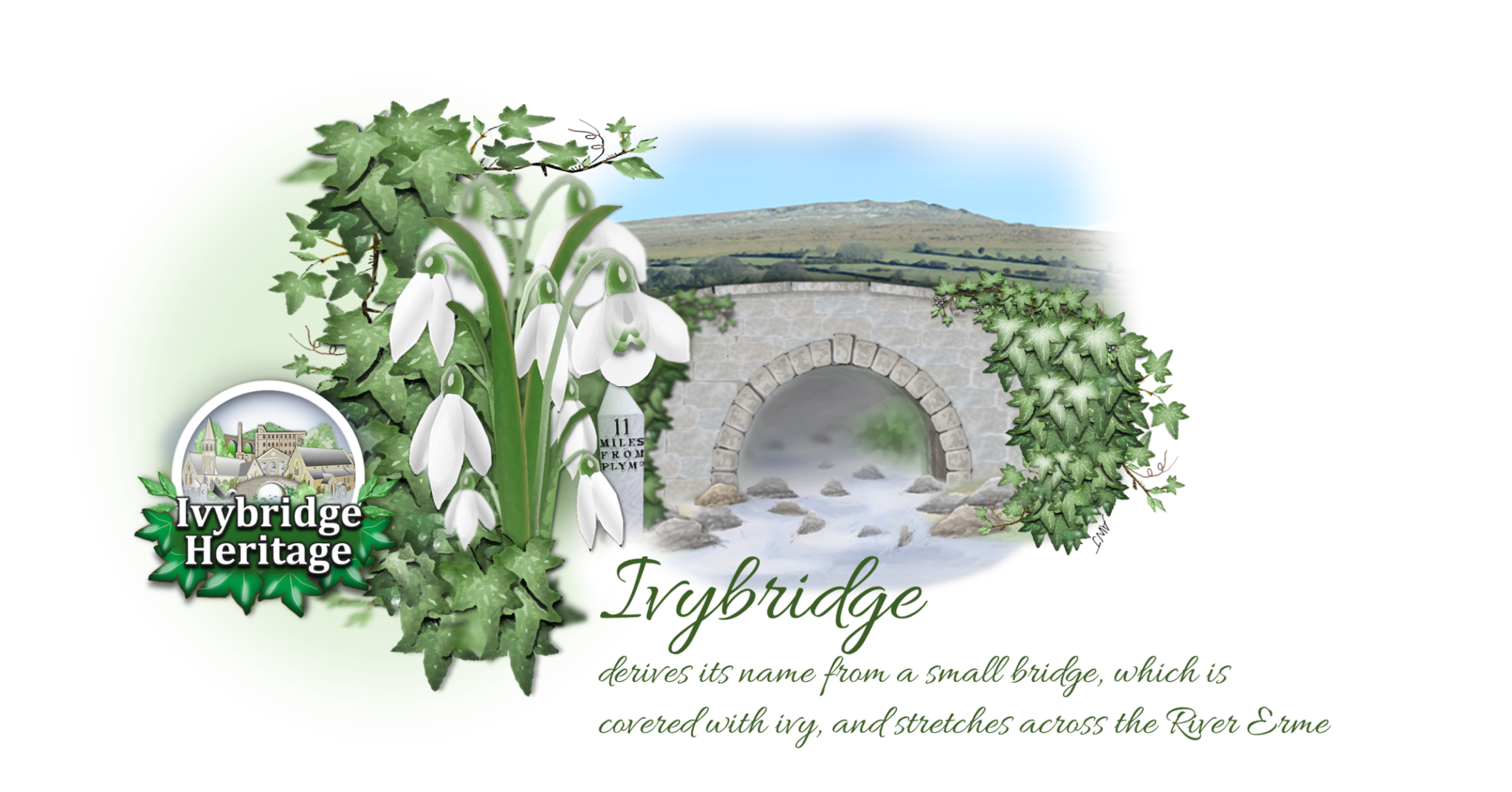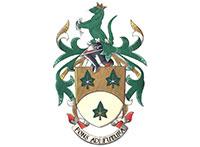

From ancient times the “King’s Highway” crossed the River Erme as a route between Exeter and Trematon Castle at Saltash. Originally, a ford crossed the river before construction in the 12th or 13th century of a packhorse bridge – the Ivy Bridge. Each corner of the bridge lay in a different parish - Harford and Ugborough on the east bank and Ermington and Cornwood on the west bank. The parishes of Harford and Ermington, at that time one of the most heavily populated areas of Devon, were then to the north east of the bridge. Harford and Stowford (originally a royal demesne) with its manor house, though never important in historical terms, would have been the main features in the area. Up until the Middle Ages Exeter remained the main centre of population in Devon, and at the time of the Conquest, Ermington was more prosperous than Plympton.
In 1280 John Peverel gave all the land in Harford to his daughter “ - And of the river which is above the Erme under Ivy Bridge”. This was to mark the beginning of a gradual development, which would become the village of Ivybridge. The area did not really establish itself as more than a manor with an adjacent farm until four centuries later. Around 1320 Ivybridge was given to an Alfred Deponte Riders which suggests that this would have been when Ivybridge became a manor, established in the vicinity of Pound Farm.
History records that in 1523 the Manor Corn Mill was sited where the Glanville’s mill shopping centre now stands. The ancient leat tunnel still exists at the road entrance to the centre. Notoriety came to the area in 1549 when John Bury, who owned most of North and South Filham and a tin mill on the Harford side of the river, became a ringleader in the “Prayer Book Rebellion” and was subsequently hanged at Tyburn in 1550. Records for 1588 show that Ivybridge consisted of two dwelling houses, a corn mill and an edge mill. There were many changes of title to land. Two records exist showing the value of Ivybridge as £2010 in 1628, and £3500 in 1692 when the great nephew of Sir Francis Drake, William Drake, sold Ivybridge to John Rogers, a Plymouth merchant.
By the 17th century the wool trade was at its height. What is now Stowford Mill (currently being redeveloped) was a tucking mill for this industry. In 1620 (the year the “Mayflower” set sail for the new world) William Hunwill had recently been allowed to build a fulling or tucking mill next to the Corn Mill. The cloth was dried on racks set up in Mill Wood roughly where Mill Meadow now stands. With a variety of tradesmen including a weaver, a blacksmith and a cider house at the bridge, this little village was becoming self-sufficient.
A market at Plympton also helped further development of Ivybridge. By this time the road through Ivybridge had become “a great thoroughfare”.
By 1785 the Ermington parish residents were complaining of the distance to Ermington Parish Church and Sir Frederick Rogers, baronet, threw his weight behind the building of an “established” chapel to stop the inevitable “loss of worshippers to the Wesleyan beliefs”. In 1786 Sir Frederick Rogers was to build a racecourse and clubhouse on Henlake Down. If you walk from Station Road to Henlake Down (one of the loveliest walks in Ivybridge) you will pass under the bridge that was once built tall enough for him to ride through without removing his top hat. With the advent of a cattle market in 1793 where Ivybridge Motors now exists, Ivybridge was guaranteed prosperous growth.
In 1812 work began on Green Street below the Highlands estate and Highland Street was to follow in 1816. Water was obtained by a series of leats. In 1813 a weir was constructed in the woods below Henlake Down. Remnants of the town’s leats can be seen in Station Road. Further evidence of a leat with water still flowing lies behind the Duke of Cornwall public house in Keaton Road. Look over the wall in Erme Road and see that a leat along with a leat gate still exists here as well.
By January 1817 the population of the village was 477 and stagecoaches were becoming the more common means of transport.
It took up to four days to travel to London with frequent coach exchanges at various hostelries. Prior to this time, the roads were not easily negotiable and most people had to travel by horseback. Coaches were finding the double bend around the Ivy Bridge awkward as they approached the London Hotel and by 1826 a bridge connecting Fore Street and Exeter Road was opened. In the early autumn of 1846 the Duke of Wellington became exasperated by the delay in the exchange of horses at Ivybridge and decided to walk to Plymouth. Enjoying the company of those he met along the road he declined a lift from a further coach. Eventually, his carriage did catch up with him and a huge reception met him when he arrived at the Royal Hotel, Plymouth.
The Kings Arms, now the Exchange public house, received its licence to trade in 1832 from Sir John Rogers. Unfortunately, the open mill leat serving the lower mills ran immediately outside the inn door. Customers leaving the premises had difficulty in avoiding this. Despite the publican’s protests to the mill owners, it remained uncovered. The public house was rebuilt and substantially changed in 1891.
By 1848 the South Devon Railway was advancing towards the border with Cornwall. Isambard Kingdom Brunel, its chief engineer, was to stay frequently in the area. Originally conceived as an atmospheric railway, a system using compressed air, it became a conventional railway line due to subsequent failures and ever-increasing costs. The viaduct was a remarkable feat of engineering for its time and remnants still stand alongside its replacement, built in 1893, both to be found in Longtimber Woods off Station Road. The top structure was wooden and various photographs and engravings of this structure are still available. Only local trains stopped at the station but the ability to reach Plymouth far quicker than before was to see the village grow significantly. The South Devon Railway was never a significant success and soon became the “Great Western Railway”. The decision to change from the broad gauge to standard gauge saw the total stretch from Exeter to Penzance being converted over one weekend – now the stuff of railway legend! Ivybridge Railway Station was closed in 1959 under the Beeching Act. A new station (funded by European money) opened in July 1994, primarily as a Park & Ride facility for Plymouth.
During 1858 John Allen, local entrepreneur, in association with the Ivybridge Gas and Coke Company, started to supply gas to the local inhabitants. Later his sons were to be involved in the provision of street lighting. In 1881 a new building was to replace the much altered and dilapidated chapel. This was to be known as “St John’s Church”. However it would not be until 1925 that, due to its dangerous state, the old chapel itself was actually demolished. John Allen was one of the main benefactors to the village. Owner of Stowford Mill and other business enterprises, he not only provided employment but also gave generously to the welfare of the village.
Ten of the houses he built for his employees in Fore Street are still known as “Allen’s Cottages.” In 1874 he funded the construction of the Methodist Church that still dominates the western entrance to Fore Street and which has become his lasting memorial. The Rogers family, as lords of the Manor, “provided land with an adequate water supply” for houses. They are also known for their connection with Dame Hannah Rogers. “Tremarron”, the house in Crescent Road, was once her “school” for poor children from Devon and Cornwall. A council school was established in 1856, now the Erme Primary School.
Electricity started to be generated in Ivybridge at the request of the urban district council in 1905. The generating station was at Lee’s Mills. Today Lloyds TSB Bank is on the site of Lee’s Mills and Mr Lee’s initials can be found cast in the pavement at its entrance. By 1916, due to ever-increasing demand for electric power, a water turbine was added to the Union Mills so that the mill could use the water through the day and electricity could be generated at night for the town. The turbine is now displayed in the car park opposite the old London Hotel (now London Court). By 1930 the enterprise had moved to the bottom mill and a massive 22-foot water-wheel erected to provide the power. The high leat still exists and provides an attractive setting alongside the river.
Two World Wars saw soldiers returning home having witnessed unexpected sights, both tragic and awe-inspiring, women had contributed significantly on the home front and the social fabric of life in both city and village was changed forever; in 1952 the last cows were driven through Fore Street.
In the 1940s, as with most of the southern coast, Ivybridge had been “home” to many American troops preparing for the June 6th 1944 liberation of Europe. One battalion, the 1st Battalion 116th Infantry Regiment from Bedford, Virginia, was to be the first battalion ashore on Omaha Beach. By the end of that first day, most of the Bedford contingent was dead. Recently Bedford became the location for the American National War Memorial. As a result of the wartime friendships made, a special relationship has grown between the two towns of Ivybridge and Bedford leading to the erection of a memorial here, signing of a Friendship Treaty and visits between the towns.
Development in terms of house building has continued apace especially with the construction of the A38 (now Devon Expressway) bypass in 1973 and reclassification of the village as a town in 1977; few of the older residents now recognise the village that once existed.
We, therefore, have good reason to ensure that the remnants and memories of those days remain as a fitting tribute to the people whose labour, tribulations, love and laughter built the unique community we enjoy today.
More Information
The Ivybridge Heritage archives contain detailed information on parts of Ivybridge view the Ivybridge Heritage archive.
Why not take the Ivybridge Heritage Trail? Find out more about the trail.
